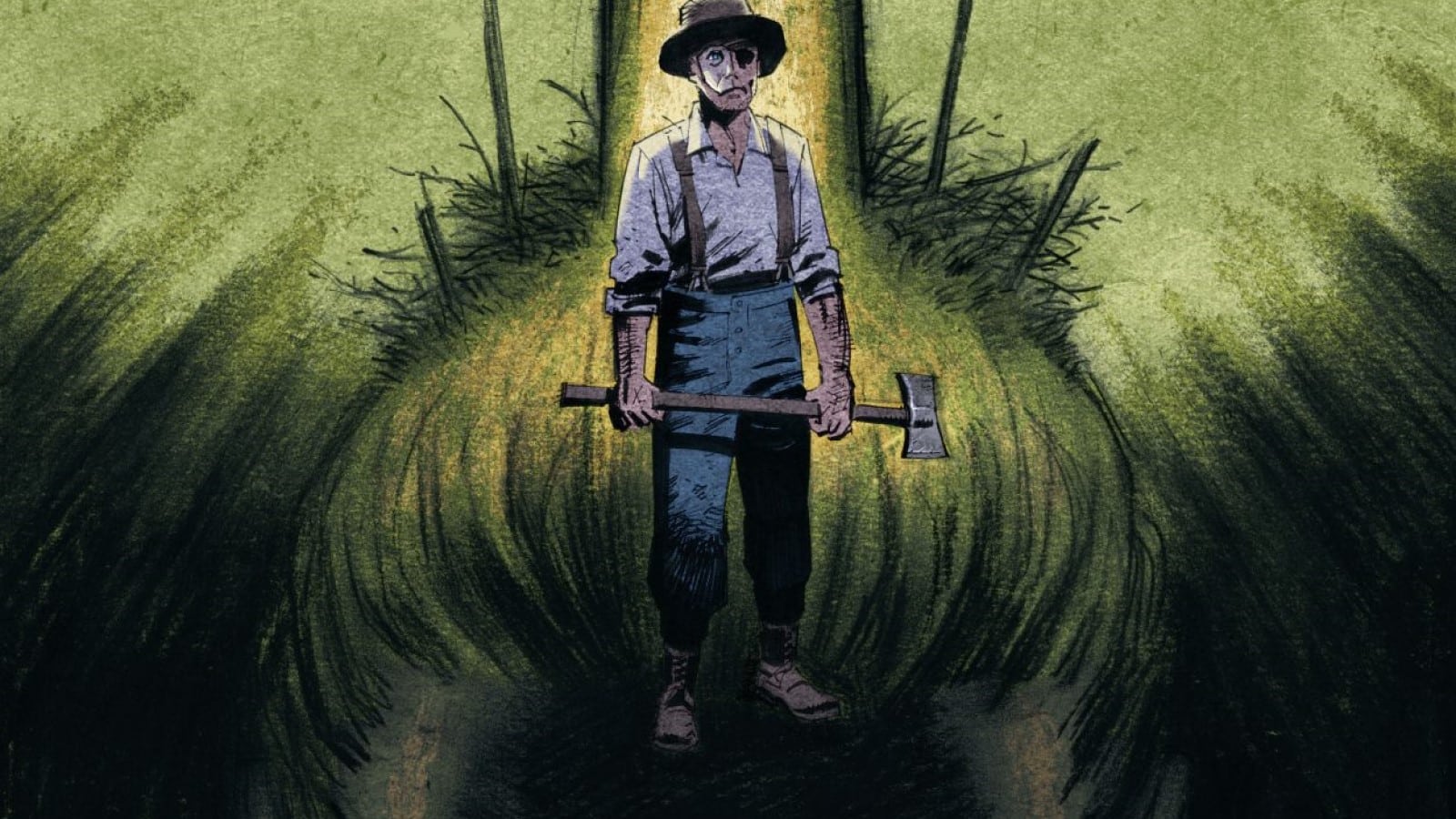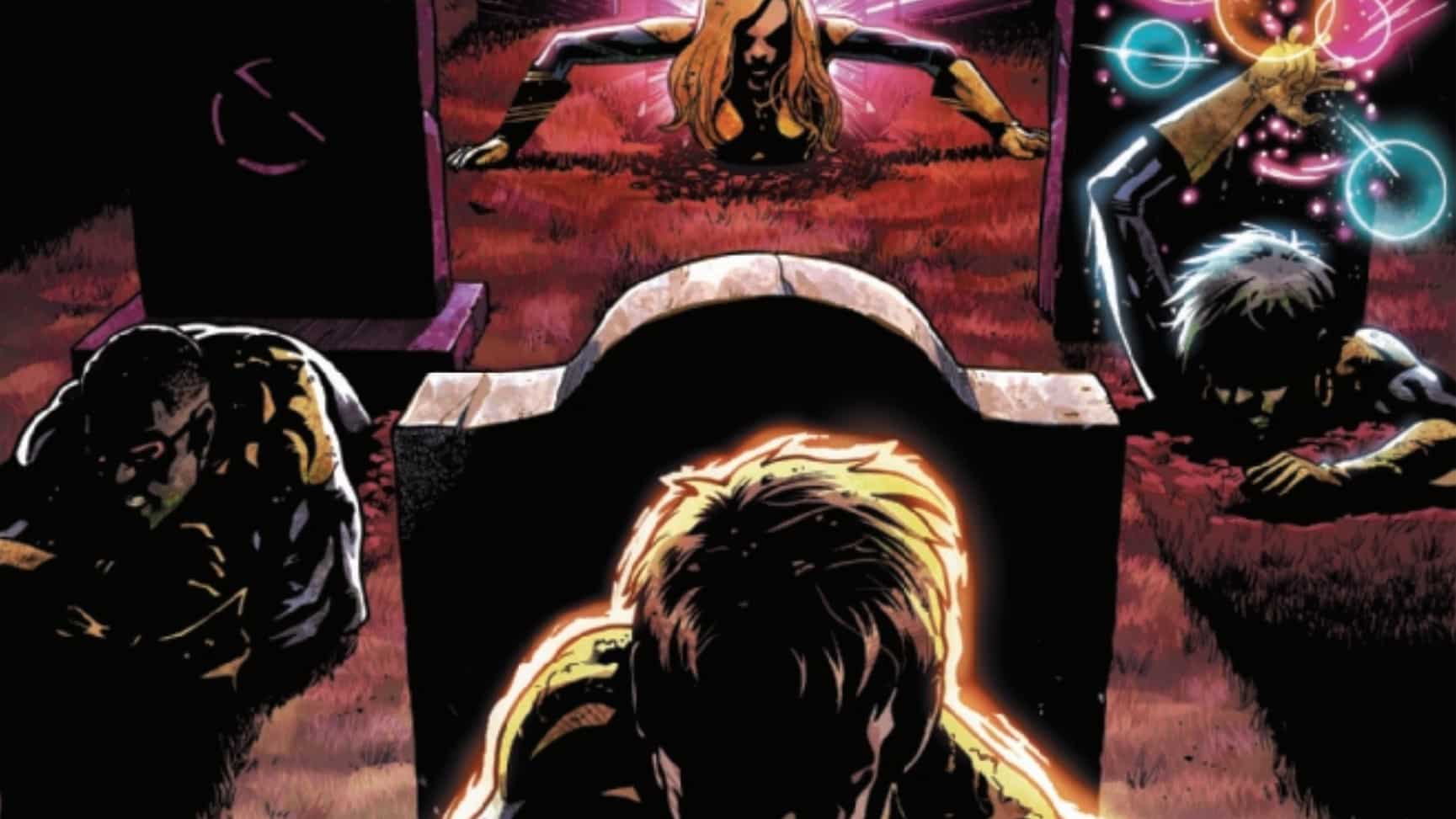Mysteries, conspiracies and sacred structures all rise up in the Canadian wilderness in Brother of All Men #2, written by Zac Thompson, drawn by Eoin Marron, colored by Mark Englert and lettered by Hassan Otsmane-Elhaou for AfterShock.
As before, I’d ask you to read Brother of All Men #2 before turning to the reflections here. This issue builds on the promise of the first while still finding new ways to haunt the reader and complicate the reading. I want to note especially a series of panels on Page 18, built like columns with captions acting as their capitals. It’s a beautiful layout unlike any I’ve seen before, a perfect microcosm of an issue that is largely about building strange and beautiful structures.
Originally I’d planned to write about those structures and devote these notes to that layout in greater detail, but on rereading, something else struck me this issue, something that I think will be of greater interest to most reading.
I’d like to consider a moment on the fifth and sixth pages of this comic. Throughout the issue, Guy has been placed on logging duty while his brother organizes the construction of some mysterious structure. Guy reflects on his nature as well as the nature of trees.
The tree cannot think; the tree experiences life, and the tree experiences death. Humanity — here represented appropriately by the detective — can, on the other hand, witness, recognize and categorize the things around them. These signs form a “language of clues” about their world. Medieval theologians often called the material world the Second Scripture, the other divinely created text which they might read to know Beauty, Goodness and, of course, Truth.
Witnessing the world and categorizing what we see is essentially similar to recording data and creating a model from that data. The activity of the poet, the scientist and the detective all rely on these same faculties, these same processes. They rely on induction. There are, of course, many problems with that. But Guy illustrates nicely a big one:
How do you isolate the data from the noise? Or one sort of meaning from another? How do you avoid conflating the hawk overhead with the stranger in the mist? How can you make sense of the code when you must construct your own cipher?
Have you watched Nathan Fielder’s The Rehearsal yet? From the building of bizarre structures to the manipulation of strange people, it is a weirdly relevant work to Brother of All Men as well as cult fiction generally. In the second episode, we meet Robin, an awful man who loves Jesus almost as much as he loves the Scion-TC. Robin has a problem I’ve encountered before (though only once to his severity) among extremely religious people and cultists: He cannot stop seeing meaning in everything. It especially manifests for him (as I’ve found it very often does) in a kind of manic numerology. Thanks above all else to digital timekeeping, but also thanks to the many other meters and markers that surround us in our daily lives, we are constantly inundated by numbers. Robin sees the measurements of time, miles to go and gas remaining as powerfully meaningful. Sure, these numbers could be random — but if they were random, if they were not some kind of omen for meeting Nathan and joining the show, then why would these particular numbers be popping up so consistently? Given how unlikely it is that numbers with personal significance or common given significance would appear, is it not reasonable to assume that these are a message?
For an extreme of this kind of thinking, look to Grant Morrison’s semiotic detective in their Passion Play.
It’s difficult to break people out of this kind of thinking because we rely on it all the time. Augury and astrology isn’t a different kind of thinking than ornithology and astronomy; all four use induction to make sense of perceived patterns in nature. The former two are simply bad inductions and operate under false paradigms. Detective stories are useful for examining aspects of this problem. In The Name of The Rose, the detective stumbles upon the truth even though he approaches the problem through a faulty paradigm. In most hardboiled detective fiction, the detective has no real chance of ever solving the mystery through investigation, reason and logic; chance, malice or sheer determination thrusts the truth upon him. In The Murder of Roger Ackroyd, though it, like all of Agatha Christie’s works, is ostensibly designed so the reader can assemble all clues and arrive at the solution, the reader is unlikely to assemble said clues properly thanks to pre-existing assumptions.
As Thomas Kuhn famously noted, we can record the movement of every planet in the sky every night of every year for centuries and centuries, and yet we will still fail to construct an accurate model of the solar system unless and until we make an intuitive leap and say: “throw out the old paradigm. What if, against all evidence we have, we were actually moving through space too?”
It takes great care to separate science from superstition, and in each of our personal lives it is extremely easy to lapse from one to the other because, again, as far as the actual action of our minds is concerned, these are essentially similar processes of data collection and pattern recognition. Intelligence and education aren’t necessarily guards against superstitious thinking either; a more intelligent mind is simply one more capable of constructing patterns, including false ones, and a more educated mind simply has more data to work with.
This is another reason why intelligent and educated people still fall prey to cults. From the outside, most of us can recognize the superstitious, magical thinking of a cult for the sham that it is. We can see the false pattern. But we’re still using the same faculties to detect that false pattern that the cultist uses to accept it. They have misperceived or miscategorized something, and proceeded in a way which seems entirely rational given that misperception or miscategorization. And once your brain has established a pattern — once you’ve decided that the hawk brings misfortune, or the Earth moves through space, or the CDC is trustworthy, or the CDC is not trustworthy, or Jesus is guiding your life, or your grandmother, from the other side, is letting you know now and then that things are OK, or that the government is watching you, or that The Work brings you peace — it is very, very good at fitting new data into that pattern. We wouldn’t be able to survive if we had to construct a new pattern every time a new piece of data entered our mind.
Sometimes you’ll see, in fiction about religious fanaticism, the fanatic grow angry at any question or doubt of their beliefs. In Brother of All Men, we see something much more realistic: Over and over again, when questioned or pushed, the believer reacts with serenity, with whatever explanation allows them to maintain their worldview. The believer doesn’t struggle with rational objection; the believer has many, given their assumptions, extremely rational replies. Anger and rejection only arise when, as we see with Brother X, the cult creates a conflict with something core to their identity.
Guy says it exactly right — we take these signs and form a narrative. We often can only begin to form a new narrative after disruption of our ability to suspend disbelief.
I’m sure we will see these problems escalate as we follow Guy — our detective with one true eye and one false eye, with a memory that he has begun to doubt — into greater mysteries.
Until then, remember that you are a pattern-making machine, not a pattern-discovering one, and that your patterns might be true, or might be monstrously, dangerously false.
Robert Secundus is an amateur-angelologist-for-hire.






